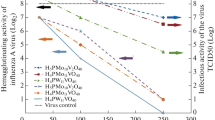Summary
Treatment of Cricket paralysis virus infectedDrosophila cells with iodoacetamide before radiolabelling with35S-methionine results in the appearance of two high molecular weight polypeptides of ≃200,000 molecular weight, not apparent in untreated infected cells (17). To attempt to differentiate between the effects of iodoacetamide being attributable to either alteration of initial polyprotein or inhibition of the protease (either cellular or viral) the effects of a spectrum of protease inhibitors were examined. These included aprotinin, leupeptin, pepstatin, elevated zinc concentration, phenyl methyl sulphonyl-fluoride, N-tosyl-L-lysine chloromethyl ketone (TLCK) and N-tosyl-L-phenylalanine chloromethyl ketone (TPCK).
TLCK and TPCK both inhibited the cleavage of proteins which demonstrates an inhibition of the protease activity. The introduction of amino acid analogues into the infected cells before pulsing also results in the appearance of higher molecular weight proteins. This could be attributed to alternation of the polyprotein making it nonsusceptible to digestion with pre-existing cellular protease or newly synthesized viral protease. The possibility that the presence of the amino acid analogues results in alteration of a viral coded protease cannot be eliminated.
Similar content being viewed by others
References
Black, D. N., Brown, F.: Proteins induced by infection with caliciviruses. J. gen. Virol.38, 75–85 (1978).
Brown, B. A., Ehrenfeld, E.: Translation of poliovirus RNAin vitro: changes in cleavage pattern and initiation sites by ribosomal salt wash. Virology97, 396–405 (1979).
Butterworth, B. E., Korant, B. D.: Characterization of the large picornaviral polypeptides produced in the presence of zinc ions. J. Virol.14, 282–291 (1974).
Celma, M. L., Ehrenfeld, E.: Translation of poliovirus RNAin vitro: detection of two different initiation sites. J. Mol. Biol.98, 761–780 (1975).
Cleveland, D. W., Fischer, S. G., Kirschner, M. W., Laemmli, U. K.: Peptide mapping by limited proteolysis in sodium dodecyl sulphate and analysis by gel electrophoresis. J. Biol. Chem.252, 1102–1106 (1977).
Gorbalenya, A. E., Svitkin, Y. V., Kazachkov, Y. A., Agol, V. I.: Encephalomyacarditis virus-specific polypeptide p 22 is involved in the processing of the viral precursor polypeptides. Febs Lett.108, 1–5 (1979).
Humphries, S., Knauert, F., Ehrenfeld, E.: Capsid protein precursor is one of two initiated products of translation of poliovirus RNAin vitro. J. Virol.30, 481–488 (1979).
Jacobson, M. F., Asso, J., Baltimore, D.: Further evidence on the formation of poliovirus proteins. J. Mol. Biol.49, 657–669 (1970).
Knauert, F., Ehrenfeld, E.: Translation of poliovirus RNAin vitro: studies on n-formylmethionine labelled polypeptides initiated in cell-free extracts prepared from poliovirus infected HeLa cells. Virology93, 537–546 (1979).
Korant, B. D.: Cleavage of poliovirus specific polypeptide aggregates. J. Virol.12, 556–563 (1973).
Laemmli, U. K.: Cleavage of structural proteins during the assembly of the head of bacteriophage T4. Nature (London)227, 680–685 (1970).
Laskey, R., Mills, A.: Quantitative film detection of3H and14C in polyacrylamide gels by flurography. Eur. J. Biochem.56, 335–341 (1975).
Lucas-Lenard, J.: Cleavage of mengovirus polyproteinsin vivo. J. Virol.14, 261–269 (1974).
Moore, N. F., Kearns, A., Pullin, J. S. K.: Characterization of cricket paralysis virus-induced polypeptides inDrosophila cells. J. Virol.33, 1–9 (1980).
Moore, N. F., Pullin, J. S. K.: Plaque purification of cricket paralysis virus using an agar overlay onDrosophila cells. J. Inverteb. Pathol. (in press).
Moore, N. F., Pullin, J. S. K., Reavy, B.: Inhibition of the induction of heat shock proteins inDrosophila melanogaster cells infected with insect picornaviruses. FEBS Letts.128, 93–96 (1981).
Moore, N. F., Reavy, B., Pullin, J. S. K.: Processing of cricket paralysis virus induced polypeptides inDrosophila cells: production of high molecular weight polypeptides by treatment with iodoacetamide. Arch. Virol.68, 1–8 (1981).
Mori, M., Miura, S., Tatibana, M., Cohen, P. P.: Characterization of a protease apparently involved in processing of pre-ornithine transcarbamylase of rat liver. Proc. Natl. Acad. Sci. U.S.A.77, 6044–7048 (1980).
Plus, N., Croizier, G., Reinganum, C., Scotti, P. D.: Cricket paralysis virus andDrosophila C virus: serological analysis and comparison of capsid polypeptides and host range. J. Inverteb. Pathol.31, 296–302 (1978).
Prives, J. M., Olden, K.: Carbohydrate requirement for expression and stability of acetylcholine receptor on the surface of embryonic muscle cells in culture. Proc. Natl. Acad. Sci. U.S.A.77, 5263–5267 (1980).
Reavy, B., Moore, N. F.:In vitro translation of cricket paralysis virus RNA. Arch. Virol.67, 175–180 (1981).
Reavy, B., Moore, N. F.: Cell-free translation of cricket paralysis virus RNA: analysis of the synthesis and processing of virus specified proteins. J. gen. Virol. (in press).
Reinganum, C.: The isolation of cricket paralysis virus from the emperor gum moth,Antherea eucalypti Scott, and its infectivity towards a range of host species. Intervirol.5, 97–102 (1975).
Reinganum, C., O'Loughlin, G. T., Hogan, T. W.: A non-occluded virus of the field cricketsTeleogryllus oceanicus andT. commodus (Orthoptera: Gryllidae). J. Inverteb. Pathol.16, 214–220 (1970).
Reinganum, C., Scotti, P. D.: Serological relations between twelve small RNA viruses of insects. J. gen. Virol.31, 131–134 (1976).
Rueckert, R. R., Matthews, T. J., Kew, O. M., Pallansch, M., McLean, C., Omkianowski, D.: Synthesis and processing of picornaviral polyproteins. In: Perez-Bercoff, R. (ed.), The Molecular Biology of Picornaviruses, 113–125. New York - London: Plenum Press 1979.
Scotti, P. D.: Cricket paralysis virus replicates in culturedDrosophila cells. Intervirol.6, 533–542 (1976).
Westaway, E. G.: Strategy of the Flavivirus genome: evidence for multiple internal initiation of translation of proteins specified by Kunjin virus in mammalian cells. Virology80, 320–335 (1977).
Author information
Authors and Affiliations
Additional information
With 3 Figures
Rights and permissions
About this article
Cite this article
Moore, N.F., Pullin, J.S.K. & Reavy, B. The intracellular proteins induced by cricket paralysis virus inDrosophila cells: The effect of protease inhibitors and amino acid analogues. Archives of Virology 70, 1–9 (1981). https://doi.org/10.1007/BF01320788
Received:
Accepted:
Issue Date:
DOI: https://doi.org/10.1007/BF01320788




